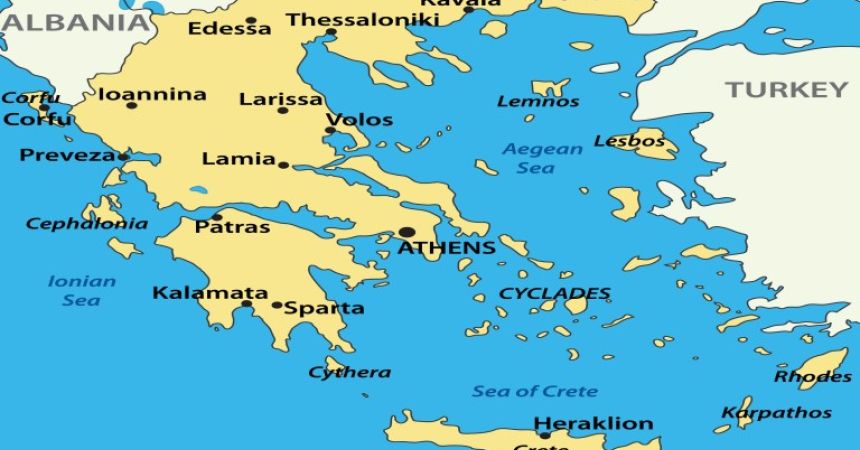
Map of Greece: Cities and Islands
Introduction
The map of Greece is a reflection of its ancient heritage, vibrant culture, and stunning natural beauty. From the rugged mountains of the mainland to the sun-kissed islands scattered across the Aegean and Ionian Seas, Greece offers a fascinating mix of landscapes and experiences. As the birthplace of Western civilization, its geography has played a crucial role in shaping its history, mythology, and culture.
Geographical Overview of Greece
Located in Southeastern Europe, Greece is bordered by:
- Albania to the northwest
- North Macedonia and Bulgaria to the north
- Turkey to the east
Surrounded by the Mediterranean, Aegean, and Ionian Seas, Greece boasts a coastline stretching over 13,676 kilometers. It covers a total area of approximately 131,957 square kilometers, including its numerous islands.
Regions of Greece on the Map
Greece is traditionally divided into 13 administrative regions (peripheries), each with its distinct character and charm:
- Attica
- Highlights: Athens, the Acropolis, and the port of Piraeus.
- Features: Urban sprawl blending ancient ruins with modernity, surrounded by mountains and the Saronic Gulf.
- Central Greece (Sterea Ellada)
- Highlights: Delphi, the “center of the world” in ancient mythology.
- Features: Mountainous landscapes and fertile plains.
- Thessaly
- Highlights: Meteora monasteries perched atop towering rock formations.
- Features: Agricultural plains and dramatic cliffs.

- Epirus
- Highlights: Zagori villages, Vikos Gorge.
- Features: Rugged mountains and lush greenery.
- Macedonia
- Highlights: Thessaloniki, Mount Olympus, Vergina.
- Features: Rich history and a blend of coastal and mountainous terrain.
- Thrace
- Highlights: Alexandroupolis, Evros River Delta.
- Features: Diverse ecosystems and cultural influences from neighboring Turkey.
- Peloponnese
- Highlights: Ancient Olympia, Mycenae, Epidaurus.
- Features: Historic ruins and scenic coastal towns.
- Crete
- Highlights: Knossos Palace, Samaria Gorge.
- Features: The largest island, with a mix of beaches, mountains, and ancient history.
- The Aegean Islands
- Highlights: Mykonos, Santorini, Rhodes.
- Features: Iconic white-washed architecture and azure waters.
- The Ionian Islands
- Highlights: Corfu, Zakynthos, Kefalonia.
- Features: Green landscapes and Venetian influences.
- Central Macedonia
- Highlights: Halkidiki, Mount Athos.
- Features: Pristine beaches and monastic heritage.
- Eastern Macedonia and Thrace
- Highlights: Kavala, Philippi.
- Features: Historical landmarks and unspoiled nature.
- Western Greece
- Highlights: Patras, Rio-Antirrio Bridge.
- Features: Coastal beauty and cultural festivals.
Mainland Greece: A Treasure Trove of History
- Athens and Surrounding Areas
- Athens is a central hub for exploring mainland Greece, with its rich historical sites like the Parthenon, Ancient Agora, and Plaka district.
- Northern Greece
- Known for its mountainous terrain, Northern Greece includes Mount Olympus, the legendary home of the gods, and the vibrant city of Thessaloniki.
- Central Greece
- Delphi, often referred to as the “navel of the Earth,” attracts history enthusiasts and spiritual seekers alike.
- Peloponnese
- A land of myths and legends, this region is dotted with ancient ruins like Corinth, Mycenae, and Sparta.
- The Islands of Greece
Greece’s islands, over 6,000 in number, are its crown jewels. They are grouped into several clusters, each offering unique experiences:
- Cyclades
- Popular Islands: Santorini, Mykonos, Paros, Naxos.
- Features: Picturesque villages, volcanic landscapes, and vibrant nightlife.
- Dodecanese
- Popular Islands: Rhodes, Kos, Patmos.
- Features: Medieval architecture and turquoise waters.
- Saronic Islands
- Popular Islands: Hydra, Spetses, Aegina.
- Features: Close to Athens, ideal for weekend getaways.
- Ionian Islands
- Popular Islands: Corfu, Zakynthos, Lefkada.
- Features: Venetian architecture, green landscapes, and sandy beaches.
- North Aegean Islands
- Popular Islands: Lesbos, Chios, Samos.
- Features: Rich in history and natural beauty.
- Crete
- The largest island, offering a blend of history, cuisine, and outdoor adventures.
Geographical Features That Define Greece
- Mountains
- Over 80% of Greece is mountainous. Mount Olympus (2,918 meters) is the highest peak, while the Pindus range is often called the “spine of Greece.”
- Seas
- The Aegean, Ionian, and Mediterranean Seas surround the mainland, contributing to Greece’s maritime legacy.
- Rivers and Lakes
- Major rivers include the Evros and Aliakmon. Lake Prespa and Lake Trichonida are among its most famous lakes.
- Climate
- Greece enjoys a Mediterranean climate with hot, dry summers and mild, wet winters.

Traveling Across Greece with a Map
- Road Trips
- The mainland offers scenic drives, such as the route from Athens to Delphi or through the Peloponnese.
- Island Hopping
- The Aegean and Ionian Seas make island-hopping adventures accessible via ferries and private boats.
- Hiking
- Maps guide trekkers through trails like the Samaria Gorge in Crete or the paths around Meteora.
- Historical Routes
- Follow the map to explore ancient wonders, from Athens’ Acropolis to the ruins of Delos.
Digital Maps and Navigation Tools
Modern maps and apps like Google Maps, Maps.me, and ferry booking platforms help travelers:
- Navigate cities and rural areas.
- Plan island-hopping itineraries.
- Discover off-the-beaten-path destinations.
Tips for Using Maps in Greece
- Learn Basic Geography: Familiarize yourself with major islands and regions to optimize travel plans.
- Use Multimodal Transport: Combine ferries, flights, Cruise to Greek Islands, and car rentals for seamless exploration.
- Plan Seasonally: Coastal regions are best in summer, while mainland Greece is ideal in spring and autumn.
Greece Trip: Beautiful Islands and Coastlines
The map of Greece is a gateway to endless adventures, offering a blend of natural beauty, historical depth, and cultural richness. Whether exploring Greece ancient ruins, hiking through rugged mountains, or relaxing on idyllic islands, every journey in Greece begins with its map. With careful planning and a sense of adventure, you can uncover the timeless charm of this Mediterranean paradise.



